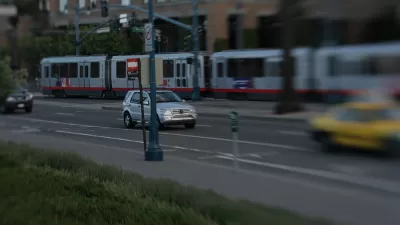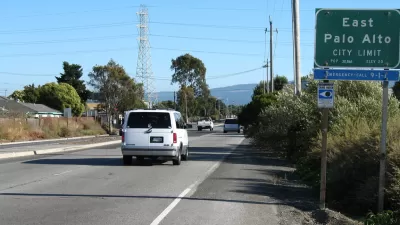Gov. Gavin Newsom vetoed a unique road pricing bill due to concerns that charging a fee would limit access to driving on two blocks of Lombard Street, a popular tourist attraction in San Francisco that is severely congested.

Assembly Bill 1605, the "Crooked Street Reservation and Pricing Program," was not a prototypical congestion or cordon pricing bill that would permit a Manhattan-like program, but it would have forced tourists to pay to drive on a public road, not unlike motorists being charged to park on a public street. Unlike parking charges, though, state legislation is required in California before cities can charge driving fees on roads they manage.
With over a million vehicles driving the “crooked street" section of Lombard Street located between Leavenworth Street and Hyde Street annually, the San Francisco County Transportation Authority devised a Lombard Crooked Street project and settled on a reservation and pricing program that Assemblyman Phil Ting introduced as legislation. The bill passed the legislature last month.
Kate Larsen, reporting from Lombard Street for the local ABC network affiliate (see the video in source article), notes that the critical component of the plan was not the fee, but the reservation element.
"The issue is not the fee, the issue is limiting the number of permits sold, to the capacity of the street," said Steve Taber, the transportation chair of the Russian Hill Neighbors association.
Taber is disappointed the Governor rejected the bill, since he views the reservations, not the fees, as the real solution to reducing congestion in his neighborhood. "You could give them away and you would still have a viable program because you would limit them."
Of course, with traditional highway congestion pricing, it's all about the fee, which increases with the level of congestion, often dynamically, meaning the toll would change every six minutes or so, ensuring that speeds do not drop below the federally mandated 45 mph.
Veto message
"As the former county supervisor representing this neighborhood, I am acutely aware of the need to address congestion and safety around Lombard Street," wrote Gov. Newsom, the former San Francisco mayor from 2004 to 2011, in his Oct. 12 veto message [pdf].
However, the pricing program proposed in this bill creates social equity issues. Access to this iconic attraction should be available to all, regardless of their ability to pay.
The fact that social equity was the key reason for the governor's veto does not augur well for real cordon pricing programs like those being considered for downtown San Francisco and Los Angeles. Social equity has proven to be a major challenge for the Los Angeles cordon pricing program. A "Road Pricing Equity Report and Toolkit" was prepared by a Bay Area nonprofit to deal with overcoming the controversial pricing aspect of cordon charges.
"I’m disappointed that the Governor vetoed AB 1605," Ting responded in an emailed statement.
Lombard Street draws up to 17,000 visitors per day on busy weekends and neither the presence of parking enforcement officers, nor the closure of the crooked segment has helped to alleviate congestion. The city is running out of options. I look forward to working with the Governor and local residents to resolve this public safety and quality of life issue.
Related in Planetizen on cordon pricing programs and legislation in California
-
Urban Congestion Pricing Might Finally Come to California, September 9, 2019
- California Unlikely to Follow New York in Allowing Urban Street Tolling, March 29, 2019
Hat tip to the International Bridge, Tunnel and Turnpike Association Smart Brief.
FULL STORY: Governor Newsom vetoes toll system for San Francisco's iconic Lombard Street

Study: Maui’s Plan to Convert Vacation Rentals to Long-Term Housing Could Cause Nearly $1 Billion Economic Loss
The plan would reduce visitor accommodation by 25,% resulting in 1,900 jobs lost.

North Texas Transit Leaders Tout Benefits of TOD for Growing Region
At a summit focused on transit-oriented development, policymakers discussed how North Texas’ expanded light rail system can serve as a tool for economic growth.

Why Should We Subsidize Public Transportation?
Many public transit agencies face financial stress due to rising costs, declining fare revenue, and declining subsidies. Transit advocates must provide a strong business case for increasing public transit funding.

How to Make US Trains Faster
Changes to boarding platforms and a switch to electric trains could improve U.S. passenger rail service without the added cost of high-speed rail.

Columbia’s Revitalized ‘Loop’ Is a Hub for Local Entrepreneurs
A focus on small businesses is helping a commercial corridor in Columbia, Missouri thrive.

Invasive Insect Threatens Minnesota’s Ash Forests
The Emerald Ash Borer is a rapidly spreading invasive pest threatening Minnesota’s ash trees, and homeowners are encouraged to plant diverse replacement species, avoid moving ash firewood, and monitor for signs of infestation.
Urban Design for Planners 1: Software Tools
This six-course series explores essential urban design concepts using open source software and equips planners with the tools they need to participate fully in the urban design process.
Planning for Universal Design
Learn the tools for implementing Universal Design in planning regulations.
City of Santa Clarita
Ascent Environmental
Institute for Housing and Urban Development Studies (IHS)
City of Grandview
Harvard GSD Executive Education
Toledo-Lucas County Plan Commissions
Salt Lake City
NYU Wagner Graduate School of Public Service





























